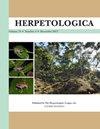暗色蝾螈的生活节奏
IF 1.1
3区 生物学
Q2 ZOOLOGY
引用次数: 0
摘要
在这篇报告中,我在平等适应度范式(EFP)的框架下,研究了北卡罗莱纳州蓝岭山脉南部两个种群中六种多齿蝾螈属的体型、年龄和资源分配的权衡。这些物种代表了与生境利用相关的三种生活史模式,即河流、河边和森林。这两个组合包括该属中最大和最小的成员。在物种中,我记录到体型与相对子代大小呈负相关,体型与终生子代数量呈正相关,但体型与终生生殖投资和生产力均呈负相关,表现为体型随相对子代大小的增加而减小。在将这些趋势与已发表的关于动物这些参数变化的数据进行比较后,我得出结论,在生命史进化的生命速度模型中,desmognathan蝾螈位于快-慢轴的慢端。我讨论了可能的种群调节机制,作为生活史模式的功能,对这些种群进行了操作,特别强调了河边物种。我认为,在河边物种中,短暂的幼虫期的保留反映了与分散相关的特征,包括生存和生长之间的权衡。本文章由计算机程序翻译,如有差异,请以英文原文为准。
Pace-Of-Life in Dusky Salamanders
In this report I examine tradeoffs involving body size, age, and resource allocation within the framework of the Equal Fitness Paradigm (EFP) in six species of plethodontid salamanders of the genus Desmognathus in two assemblages in the southern Blue Ridge Mountains of North Carolina. The species are representative of the three life-history modes associated with habitat utilization in Desmognathus, namely stream, streamside, and forest. The two assemblages include the largest and smallest members of the genus. Among species, I recorded a negative correlation between body size and relative offspring size, a positive correlation between body size and lifetime offspring number, but negative correlations between body size and both lifetime reproductive investment and productivity, as reflected in the decrease in body size with increasing relative offspring size. In comparing these trends with published data on variation in these parameters in animals generally, I conclude that desmognathan salamanders lie at the slow end of the fast–slow axis in the pace-of-life model of life-history evolution. I discuss possible population regulatory mechanisms that operate on these populations, as a function of life-history mode, with special emphasis on streamside species. I suggest that retention of a brief larval phase in streamside species reflects tradeoffs among dispersal-related traits, including survival and growth.
求助全文
通过发布文献求助,成功后即可免费获取论文全文。
去求助
来源期刊

Herpetologica
生物-动物学
CiteScore
4.60
自引率
0.00%
发文量
27
审稿时长
>12 weeks
期刊介绍:
Established in 1936, Herpetologica is a quarterly peer-reviewed journal serving herpetologists, biologists, ecologists, conservationists, researchers and the scientific community. The journal contains original research papers and essays about the biology of reptiles and amphibians, and covers many relevant topics including: behavior, conservation, ecology, genetics, morphology, physiology and taxonomy.
 求助内容:
求助内容: 应助结果提醒方式:
应助结果提醒方式:


